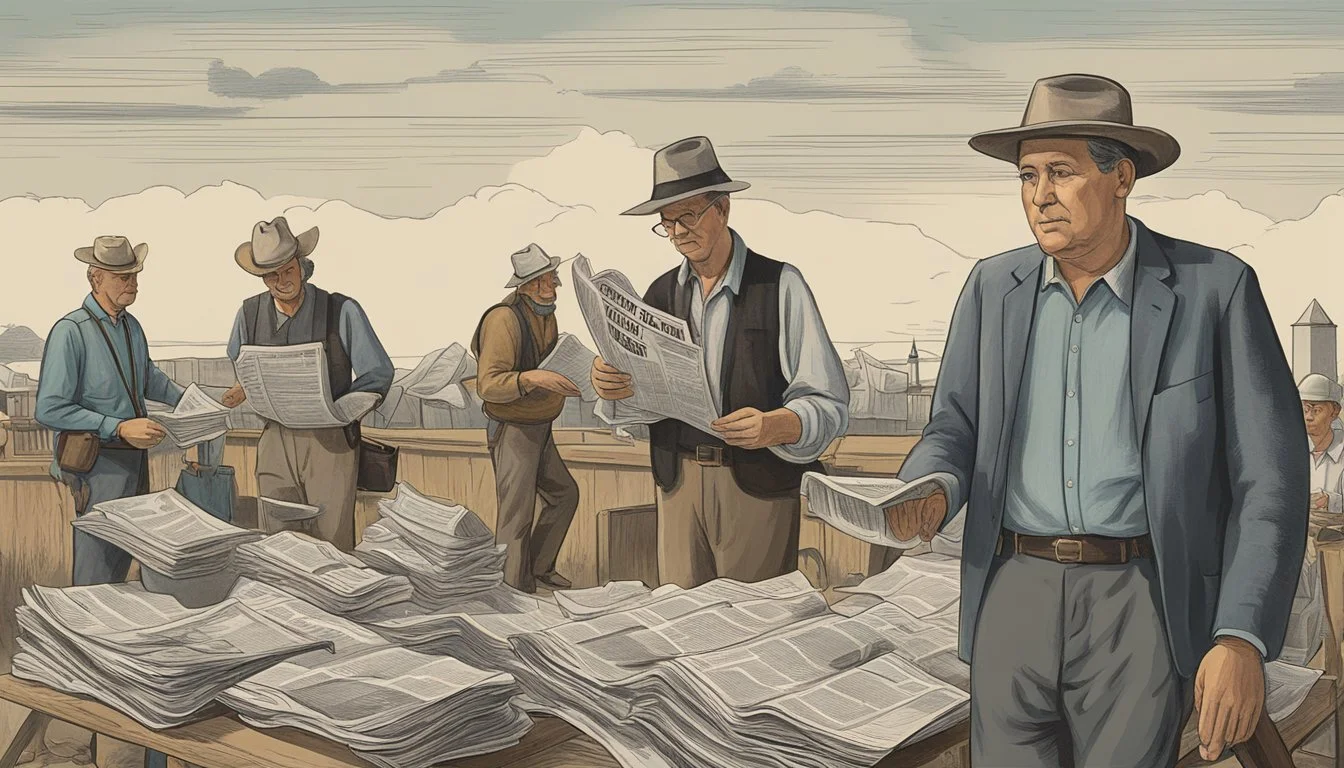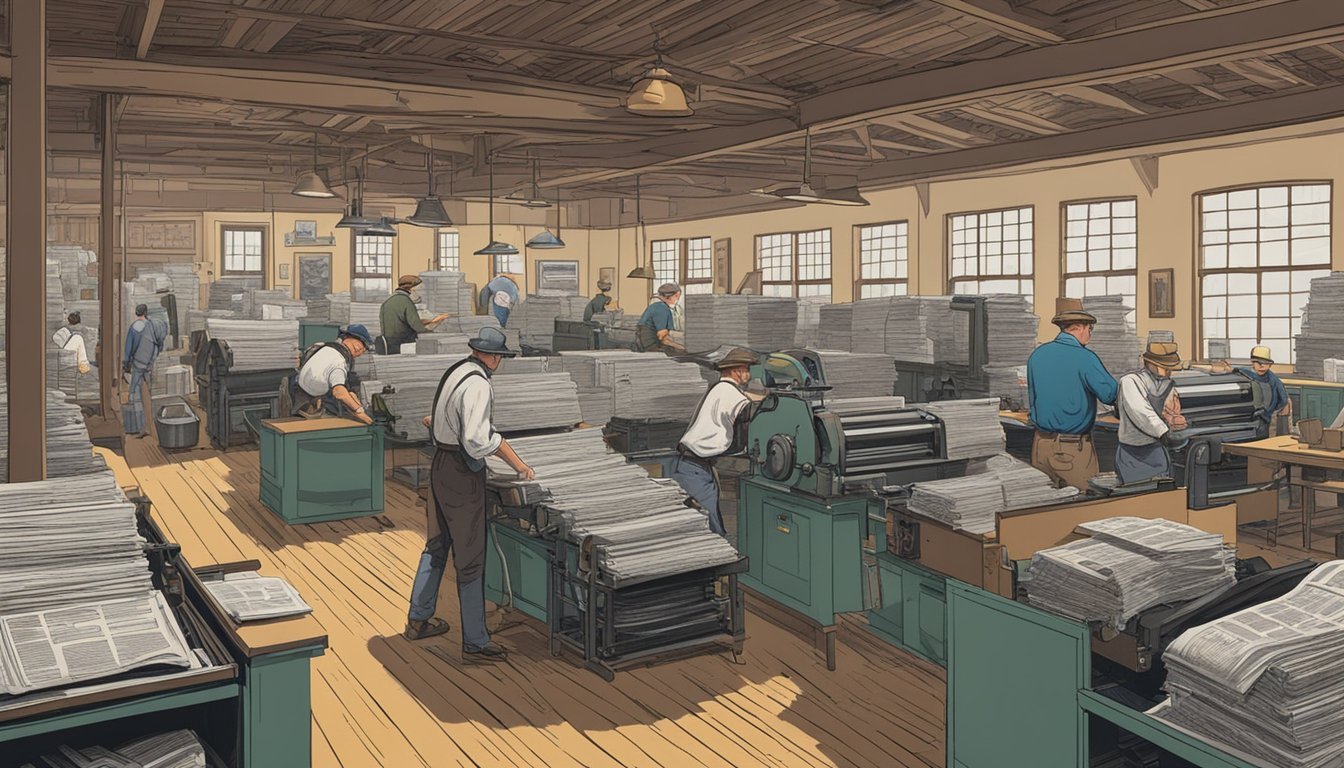The Impact of German Immigrants on Texas Journalism
Cultural Infusion and Media Evolution
The landscape of Texas journalism has been indelibly shaped by the contributions of German immigrants. Arriving in Texas in significant numbers during the 19th century, Germans established communities and institutions, including newspapers that catered to their language and cultural preferences. As early as 1853, San Antonio Zeitung emerged to serve the German population in West Texas, fostering a conduit for social, political, and cultural exchange.
These publications provided more than just news; they became platforms for advocacy and integration, helping German Texans maintain their heritage while acclimating to their new surroundings. The cessation of the German section in mainstream newspapers like the San Antonio Zeitung in 1957 marks a point of linguistic and cultural assimilation, reflecting the gradual integration of German Texans into the broader tapestry of state identity.
Moreover, the ethos brought by the German immigrants has left a mark on the Texan work ethic and adaptability within the field of journalism. The legacy of the German Texans' dedication to their craft can be seen through various aspects of journalistic practice in the state, illustrating how the intertwining of cultures has enhanced the profession. Texas, known for its diverse cultural influences, owes a part of its journalistic history to the contributions and perspectives of its German settlers.
Early German Immigration to Texas
In the early to mid-19th century, significant waves of German immigrants arrived in Texas, driven by social, economic, and political factors. They fundamentally shaped the state's cultural landscape, including its journalism.
Origins of German Migration
German immigration to Texas began as early as the 1830s, with individuals seeking new opportunities in what they viewed as the abundant and fertile lands of Texas. Rural Germany faced overpopulation and economic hardships, which prompted many to seek better living conditions abroad. These immigrants brought diverse trades, beliefs, and hopes for prosperity to the Texan frontier.
Adelsverein and Colonization Efforts
The "Society for the Protection of German Immigrants in Texas," also known as the Adelsverein, was formed in 1842 to facilitate the organized emigration of Germans to Texas. It aimed to establish new settlements and support immigrants upon their arrival. Key figures in German-Texan immigration history include Johann Friedrich Ernst, who was among the first Germans to settle there, and Prince Carl of Solms-Braunfels, who played a vital role in guiding immigrants.
The Adelsverein was instrumental in the establishment of numerous towns, including:
New Braunfels (established in 1845)
Fredericksburg (established in 1846)
Settlement Patterns
The majority of German immigrants arrived in Texas through the port of Galveston and moved inland to areas of Central Texas. They settled primarily in rural areas, creating tight-knit communities centered around farming and industry. The German population in Texas grew significantly over the years, representing more than five percent of the state's population by 1900. These immigrants left an indelible mark on the region's socioeconomic fabric, including its journalistic enterprises.
Cultural Impact and Integration
German immigrants significantly influenced the linguistic, cultural, and societal landscape of Texas, embedding their traditions into the state’s DNA while forging a unique German-Texan identity.
Language and Education
Within the realm of language, the fusion of German immigrants' linguistic traditions and the educational framework of Texas was evident. Texas German, a dialect unique to the state, emerged as a mix of High German with English loanwords, reflecting the adaptation of German settlers. As German immigrants established schools, they propagated not only their mother tongue but also their rigorous standards for education.
Languages Taught: German, English, Spanish
Notable Impact: Preservation of the German language in certain concentrations; introduction of bilingual educational models
Customs and Traditions
German immigrants brought with them a rich tapestry of customs and traditions that found a new home in Texas. Festivals like Oktoberfest, Weihnachten (Christmas), and Easter customs became part and parcel of the Texan cultural calendar. Food such as sausages, beers, and breads became culinary staples. German music and dance also enriched the local culture, adding to the state's ethnic and cultural diversity.
Cultural Imports: Festivals, food, music, dance
Continuation: Annual celebrations and culinary influence
Integration into Texan Society
The integration into Texan society saw Germans contributing to various sectors, seamlessly merging into the fabric of American life while still retaining elements of their heritage. Despite the decline of German-language journalism by the 1940s, they had established a firm presence within the state, participating fully in public life. The acknowledgment of Germans as an influential ethnic group within Texas is cemented by their contributions to the state’s culture, education, and societal structures.
Representation: Approximately 17% of Texas's population were of German descent by 1990, indicating the scale of their societal incorporation.
Cultural Synthesis: A blend of German customs with Texan norms, showcasing a successful cultural assimilation.
German Texans in the Press Industry
German immigrants in Texas established a number of newspapers, contributing significantly to the state's journalistic landscape. These publications not only covered local and international news but also played a pivotal role in maintaining the German language and culture within the state.
Founding of Newspapers
German Texans founded several noteworthy newspapers during the 19th century. The San Antonio Zeitung, which began on July 1, 1853, served as a vital news source for German-speaking residents in West Texas. Galveston Zeitung, another prominent newspaper, provided readers with local, regional, and European news, bridging the gap between the new world and the old continent.
Coverage and Influence
The newspapers established by German immigrants had a diverse range of coverage. They reported on political, social, and cultural news, thereby exerting influence over their readership. The German press in Texas helped shape public opinion and provided a platform for discussing significant issues of the day.
Preservation of German Identity in Journalism
In an effort to maintain their cultural identity, German Texans used their newspapers to preserve the German language and traditions. Journalism became an instrument through which the population could express and perpetuate their heritage, ensuring that future generations of German Texans could stay connected to their roots.
Socioeconomic Contributions
German immigrants have made significant marks on Texas, especially within trade, industry, and agricultural development. Their ingenuity and work ethic helped shape Texas' socioeconomic landscape.
Trade and Industry
German settlers quickly integrated into Texas' economic fabric, bringing skills that significantly bolstered local industry and trade. Textiles, equipment, and metal works were sectors where Germans particularly excelled, reflecting their diverse craftsmanship. They established businesses and trade networks that facilitated the exchange of goods not only within Texas but also beyond its borders. For example, they had a hand in developing the brewing industry, with their beer-making expertise leading to the establishment of numerous local breweries.
Land Development and Agriculture
The Texas Hill Country saw a transformation at the hands of German settlers, who capitalized on the fertile lands and the opportunities for development. They received land grants and utilized the area's natural resources to cultivate various crops and contribute to the state's agricultural growth. Their presence in rural Texas was marked by the introduction of techniques that maximized the yield from the often challenging terrain of the Hill Country.
Cotton and Corn: Staple crops such as cotton and corn flourished under German farming techniques.
Orchards and Vineyards: They also contributed to horticulture, with the planting of orchards and the introduction of vineyards, enhancing agricultural diversity.
Political Influence and Military Involvement
German immigrants in Texas played a significant role in shaping the state's political landscape and contributed to its military endeavors, particularly during the Civil War and the World Wars.
Civil War and Confederate Support
During the Civil War, German immigrants in Texas found themselves in a complex situation. While many Germans were opposed to slavery due to their political leanings towards republicanism and liberalism, a number found themselves aligning with the Confederacy for various reasons, including economic pressure and community ties. Their participation in the war was marked by the formation of German regiments within the Confederate forces. However, the political turmoil led to internal conflict within the German-Texan community, evidenced by events such as the Nueces Massacre, where pro-Union German Texans were killed while attempting to flee to Mexico.
World Wars and National Perception
World War I saw a shift in the perception of German-Texans as the United States fought against Germany. The community's loyalty was often questioned, and many experienced a reduction of civil liberties along with suspicion and hostility from non-German neighbors. Despite this, German-Texans served in the military, and Texas itself was home to training camps for American soldiers heading to Europe.
During World War II, German-Texans once more found their allegiance questioned. At the same time, they contributed to the war effort both on the home front and in military service. Texas hosted prisoner of war (POW) camps for German soldiers, and many German-Texans played a role in interacting with and sometimes even aiding in the re-education of these POWs. Despite facing scrutiny, the Texas German community helped support America's military objectives while working to maintain their cultural identity.
Legacy of German Immigrants in Texas
The significant impact of German immigration on Texas' culture and society is evident in the state's media landscape and cultural expressions. This enduring legacy is particularly noticeable in the context of journalism and public festivals.
Modern Perception
The influence of German immigrants on Texas journalism is lasting, with the state's media reflecting values like diligence and precision often associated with German culture. Texas German, a dialect that emerged from the mix of German dialects brought by immigrants, represents the linguistic contributions that have filtered into local expressions, even if the language itself is waning.
Cultural Festivals and Remembrance
German cultural heritage in Texas is celebrated through a variety of events and festivals. The most notable of these is Oktoberfest, celebrated in numerous Texan cities, prominently showcasing German culture. The following list outlines key annual celebrations:
Wurstfest: A ten-day festival in New Braunfels, focusing on German sausages, music, and dance.
Maifest: A spring festival in Brenham, featuring German food, music, and heritage displays.
Oktoberfest: Held in Fredericksburg, amongst other cities, it is an authentic reflection of the town’s German roots.
These festivals serve as conduits for Texas's German legacy, continuing traditions of migration and cultural amalgamation that have shaped the state’s identity over the centuries.







